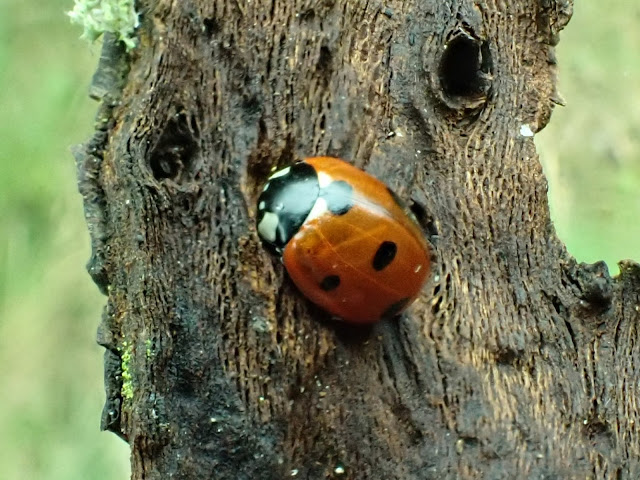Plants
The BSBI New Year Plant hunt was held in mild weather but the December cold spell reduced surviving blooms, with 29 species in flower, after the record 46 in 2022. Common Ramping-fumitory Fumaria muralis was a new species for the Warren hunt, with Mediterranean Euphorbia characias, Petty E. peplus and Portland Spurge E. portlandica still in flower, plus typical performances from Daisy Bellis perrenis, Dandelion Taraxacum agg, Gorse Ulex europaeus, Ragwort Senecio jacobaea and Yarrow Achillea millefolium.
Early Forget-me-not - Kevin Rylands
A total of 458 species were recorded during the year, (cf. 440 in 2022 & 438 in 2021), including five species and two hybrids new to the Recording Area flora, although four of these were non-natives; New Zealand Flax Phormium tenax, at least the tenth non-native plant species to have self seeded from the various plantings adjacent to the SAC, Many-flowered Rose Rosa multiflora, Argentinian Vervain Verbena bonariensis and Forsythia F x intermedia.
The three natives were Fool's Parsley Aethusa cynapium, Wild Mignonette Reseda lutea and the rare hybrid between Smooth Cat's-ear and Cat's-ear, Hypochaeris x intermedia.
Wild Mignonette - Kevin Rylands
A total of 16 plants were recorded for the first time in at least five years, several of which had not been noted for over a decade, including Cut-leaved Dead-nettle Lamium hybridum, Henbit Dead-nettle Lamium amplexicaule, Field Madder Sherardia arvensis and Hazel Corylus avellana.
Henbit - Kevin Rylands
Sand Crocus Romulea columnae first emerged on 25th Mar, three days later than 2022 but in much better numbers, despite the weather. Results of a full survey on Wildlife Trust land are awaited.
Sand Crocus (when cloudy) - Kevin Rylands
Populations of Mossy Stonecrop Crassula tillea around the Golf Course and Buffer Zone continued to expand, as did areas of Shepherd’s Cress Teesdalia nudicaulis, Smith's Pepperwort Lepidium heterophyllum and Crosswort Galium cruciata.
Crosswort - Kevin Rylands
As last year a late autumn repeat flowering of several species such Dogwood Cornus sanguinea and Bramble Rubus sp.. A Tomato Solanum lycopersicum plant growing amongst the exposed gabions was perhaps introduced by South West Water, but other strandline plants suffered from continued erosion with only two Sea Holly Eryngium maritimum left in the remaining Desert on Warren Point.
Green-winged Orchid Orchis morio had a good year, last year's plant on Warren Point flowered again, with three others appearing, along the Back Path, in the rough on the 7th hole and by the Main Pond, the 10-12th individual flowering plants on site.
Green-winged Orchid - Kevin Rylands
On Warren Point the small colony of Pyramidal Orchid Anacamptis pyramidalis climbed back to 17 flowering plants this year, with new plants in Greenland Lake and on the Dune Ridge, Southern Marsh Orchid Dactylorhiza praetermissa emerged on 7th May and but on a good display and Bee Orchid Ophrys apifera emerged on 1st June with over 20 spikes recorded.
Bee Orchid - Alan Keatley
The last orchids of the year, Marsh Helleborine Epipactis palustris and Autumn Ladies-tresses Spiranthes spiralis, were out in numbers across Greenland Lake, the latter in the thousands. The 2017 work on the beach aimed to return the 'lake' to a tidal creek, with the vast majority of these disappearing under the tide so enjoy them whilst you can.
Autumn Ladies-tresses - Alan Keatley
Dawlish Warren Flora
Mosses & Liverworts
The nationally rare liverworts Micheli's Balloonwort Sphaerocarpos michelii and Blue Crystalwort Riccia crystallina maintained their populations on bare areas around the Go-karts and car park. The Recording Area is one of two Devon locations, with the other just the mainland side of the Railway Tunnel.
Micheli's Balloonwort Sphaerocarpos michelii and Blue Crystalwort Riccia crystallina - Kevin Rylands Two of the 33 species recorded were new for the audit, Common Threadwort Cephaloziella divaricata, in the fixed dune on Warren Point and the widespread Creeping Feather-moss Amblystegium serpens.
Common Threadwort Cephaloziella divaricata being colonised by the lichen Diploschistes muscorum - Kevin Rylands
Lichens
A total of 67 species were noted, with two new to the Recording Area, Peltigera praetextata, a dog-lichen and Toninia episema, a lichenicolous lichen growing on Aspicilia calcarea.
Elsewhere several patches of the scarce dog-lichen Peltigera neckeri were found on the Dune Ridge, a more secure population than that still being lost at Warren Point.
Fungi
A total of 194 species were recorded, 29 of which were new for the Recording Area, although the findings of the Devon Fungus Group mtg in November are not yet available, so further additions are anticipated.
Bay Triangle Coccomyces delta - Kevin Rylands
New species included Bay Triangle Coccomyces delta, also new for Devon, Grey Inkcap Coprinopsis cinerea, a Sycamore leaf spike Gnomonia cerastris, Allium Rust Puccinia porri, Granulated Cup Peziza granulosa, an orange disc Pyronema domesticum and on their unfortunate victims Entomophthora muscae and Beauveria bassiana.
Entomophthora muscae on Scathophaga sp. - Kevin Rylands
Other records included Nectriopsis lecanodes on Langstone Rock, one of only four English sites, Collared Earthstar Geastrum triplex, Dune Cup Peziza ammophila and Gibberella gordonii on Spartina Ergot Claviceps purpurea var spartinae.
Collared Earthstar Geastrum triplex - Alan Keatley
Algae
A total of 25 seaweeds were identified during the year, including three new for the Recording Area, taking the audit to 64 species. The new species were False Irish Moss Mastocarpus stellatus at Langstone Rock, Hen Pen Bryopsis plumosa on the strandline and Guiry's Wrack Fucus guiryi on the seaward end of the new groynes.
Serrated Wrack Fucus serratus - Kevin Rylands

















%20110124.jpg)
















%20131223.jpg)
